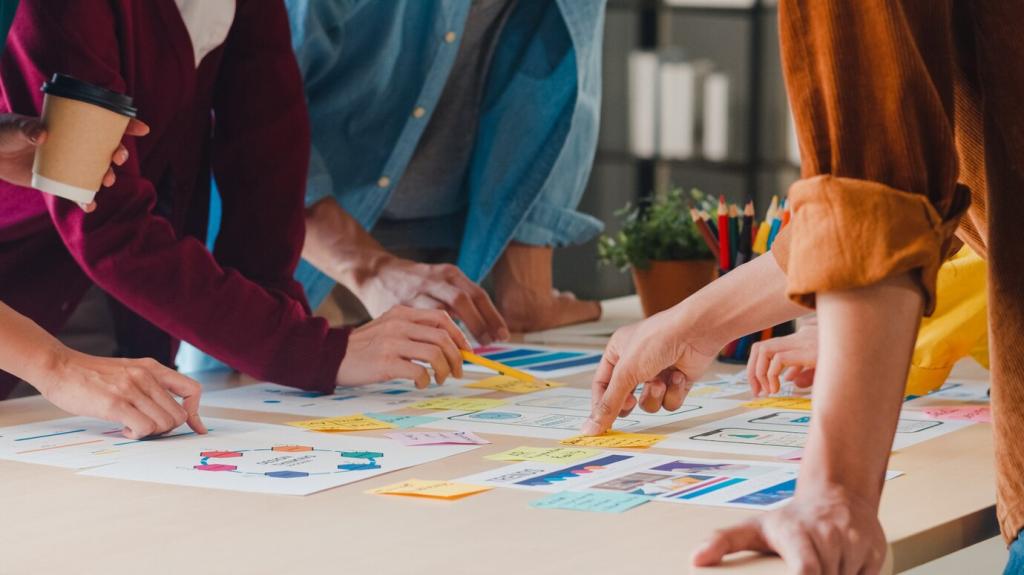Modern Desk Arrangements for Productivity
Discovering the most effective desk arrangements is essential for building a workspace that not only looks modern but also maximizes your productivity. The ways in which you arrange your desk and surrounding environment can have a direct impact on your focus, workflow, and even your well-being. This guide explores the latest trends and principles behind modern desk setups, offering insights and inspiration for both remote workers and office professionals seeking to optimize their workspace for peak performance.

The Science of Workspace Design
Ergonomics and Comfort
Good ergonomics is fundamental to any productive workspace. Ensuring that your chair, desk height, and monitor placement align with your body’s natural posture reduces physical strain and fatigue over long working hours. When your desk supports comfortable seating and correct hand positioning, you are less likely to suffer from repetitive strain injuries or discomfort, which can significantly hinder productivity. Incorporating adjustable furniture and ergonomic accessories, such as wrist supports or footrests, adds another level of customization that can be tailored to your specific needs. These subtle adjustments facilitate better concentration and help maintain energy levels throughout the day, subtly reinforcing productive habits.
Lighting and Mood
Lighting deeply influences mood and productivity within any workspace. Natural daylight has proven benefits for alertness and emotional well-being, so positioning your desk near a window can infuse your setup with invigorating light. Where natural light isn’t possible, using adjustable LED desk lamps that replicate daylight can minimize eye strain and foster a sense of clarity. The right balance of overhead and task lighting will prevent harsh shadows or screen glare, helping you stay focused for longer periods. A well-lit desk arrangement not only supports productivity but also creates a pleasant atmosphere that makes daily work more enjoyable and inspiring.
Color and Ambience
The color palette you choose for your workspace can subtly shape your mental state and work output. Muted tones like soft blues or greens are known to encourage calmness and sustained attention, while warmer hues can stimulate energy and creativity. Integrating these colors into your desk arrangement through accessories, wall paint, or even screen backgrounds personalizes your space and can positively impact your mood. Coupling thoughtful color choices with elements like plants or minimalist decor establishes a modern, uncluttered ambience, reducing distractions and maintaining a professional, yet inviting, environment.
Minimalism for Maximum Focus
01
Keeping only what you need on your desk is the foundational principle of minimalism. By removing unnecessary items, paperwork, or gadgets, you can create an environment that encourages clear thinking and efficient task completion. Minimalism is not just about style; it is a deliberate approach to organizing your workspace in a way that makes distractions less likely and decision-making simpler. The presence of only essential tools, such as your computer, notepad, and perhaps a single writing instrument, allows your mind to zero in on the task at hand without constant visual interruptions. This physical order often translates to mental order, enhancing your productivity throughout the day.
02
Smart storage is at the heart of every successful minimalist desk arrangement. Utilizing drawers, shelves, or hidden compartments helps maintain a tidy desktop without sacrificing access to important items. By keeping storage within arm’s reach but out of direct sight, you can swiftly retrieve files or supplies without disrupting your workflow. This approach ensures that your workspace appears serene and uncluttered, allowing you to enjoy the aesthetic benefits of minimalism while still retaining practical functionality. Investing in high-quality storage solutions, whether modular organizers or under-desk cabinets, can further streamline your daily routines and uphold a consistently organized environment.
03
Minimalism doesn’t stop at the physical desktop; it extends to the digital realm as well. Organizing files, emails, and digital workspaces helps prevent information overload and streamlines your workflow. Creating a consistent file naming system, setting up folders for different projects, and regularly clearing digital clutter on your desktop reduces mental fatigue and wasted time. With a well-ordered digital environment, you’re able to quickly locate documents and minimize moments spent searching for information, thus supporting uninterrupted productivity. Digital minimalism, paired with a physically clean desk, enhances a sense of control and calm, making it easier to tackle daily challenges with confidence.
Meaningful Decor
Incorporating meaningful decor, such as a favorite photograph, a piece of art, or a motivational quote, goes beyond mere aesthetics. These elements act as visual anchors throughout your workday, subtly reminding you of your goals, values, or loved ones. The presence of familiar and uplifting items creates a sense of belonging and comfort, transforming your desk from a generic setup into a personalized haven. This emotional connectivity can enhance your focus and strengthen your motivation, making it easier to overcome challenges and remain engaged with your tasks, even on demanding days.
Productivity Tools
Strategically placed productivity tools, chosen with care, play a pivotal role in keeping you on track and organized. Items such as a stylish planner, a high-quality notebook, or a digital assistant can support task management and goal setting. When your desk arrangement allows for effortless access to these tools, you’re more likely to stick to your routines and efficiently manage workloads. Modern productivity tools are often designed to blend functionality with aesthetic appeal, ensuring they complement the overall look of your space while serving as practical aids. Investing in the right tools can make daily workflows seamless and instill a sense of professionalism in your approach.
Personal Growth Elements
Including items that promote personal growth, such as a stack of favorite books, a gratitude journal, or inspirational reminders, can continually nurture your mindset as you work. These objects signal your commitment to ongoing improvement and serve as gentle prompts to pause, reflect, and celebrate progress. The intentional placement of such elements within your desk arrangement ensures they are within sight, quietly motivating you to keep developing skills and knowledge. Over time, the integration of personal growth items fosters a proactive attitude toward self-improvement, which can have a ripple effect on your productivity and overall sense of fulfillment.
Join our mailing list
